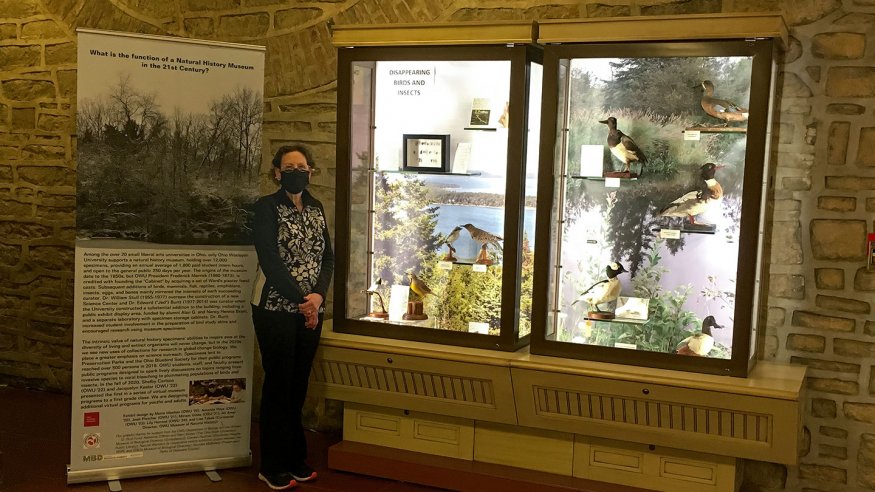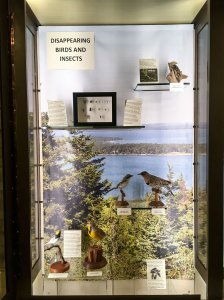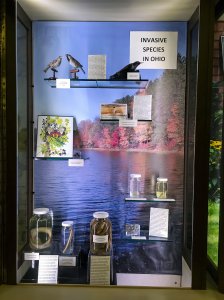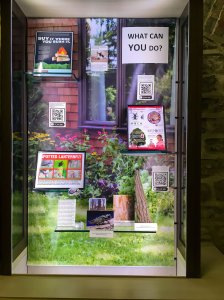
A Capitol Collection
Ohio Wesleyan’s Natural History Museum Installs Display at Ohio Statehouse
Through June 19, a natural history exhibit created by Ohio Wesleyan University students and staff member Lisa Tabak is on display at the Ohio Statehouse Museum Education Center.
The OWU exhibit fills four display cases within the Map Room of the Statehouse, located at 1 Capital Square, Columbus. Guided tours aren’t available right now, but visitors are permitted to enter the basement-level Map Room (near the gift shop) and explore the exhibit on their own.
The display is based on research conducted by Ohio Wesleyan students working under the supervision of Tabak, curatorial director of the OWU Natural History Museum, a repository of more than 12,000 specimens and artifacts.
In addition to allowing guests to tour OWU’s exhibit independently, Statehouse staff also are creating a video of Tabak discussing the display. Filmed in February during the five-hour exhibit installation, the video will debut on the Statehouse Museum’s YouTube channel when completed.
An OWU First

“The exhibit is Ohio Wesleyan’s first at the Statehouse,” Tabak said, and is representative of the breadth and depth of the work conducted at the OWU Natural History Museum.
Topics covered in the exhibit include “Disappearing Birds and Insects,” “Invasive Species in Ohio,” and “What Can You Do?”, an overview that includes QR codes to help viewers learn more. It also includes a large banner displaying information about the OWU museum and the function of such museums in the 21st century.
The display cases were designed by Tabak in collaboration with Bishops Amanda Hays ’20, Josh Pletcher ’21, Moira Meehan ’20, Ali Amer ’23, and Lily Herreid ’24. Tabak also received some design assistance from her daughter, Miriam Gibbs, a student at The Ohio State University.
From OWU to Russia
As a student, Amanda Hays spent two years working at the on-campus museum. Research that she completed in collaboration with Josh Pletcher is featured in the invasive species exhibit.
Hays used her museum experience to help earn a University-funded OWU Connection grant to travel in 2019 to St. Petersburg, Russia. There, she completed an internship at the Hermitage State Museum, the second-largest art museum in the world.
“The skills and knowledge I gained from working at Ohio Wesleyan’s Natural History Museum have helped me in the past and will continue to help me in the future,” said Hays, an OWU History and Pre-Law double major and Classics minor.
She plans to attend law school in the fall, with a long-term goal of becoming a museum/arts attorney working in cultural heritage law.
Bishops in Connecticut

Both Pletcher and Moira Meehan also used their Natural History Museum experience to help them earn OWU Connection funds to explore their academic interests. In early 2020, they spent a week in Connecticut learning about the Peabody Museum of Natural History at Yale University.
As an OWU museum intern, Pletcher also researched data aggregators for digital records, helping the museum to improve and expand its electronic record-keeping.
“This was initially an outgrowth of work I did researching the history of the museum in the OWU Historical Collection, in particular a set of Ward’s fossil casts that the University acquired in 1869,” said Pletcher, a Pre-Professional Zoology and Geology double major and a History minor.
“To properly catalog these casts and make them more accessible to the general public, I explored various digitization options,” he said. “Eventually, we settled on Arctos, which is a collaborative collections management software.”
Of Mudsnails and Museums

Pletcher said working on the invasive species project, now represented in the Statehouse display, helped him to secure a position last summer as a boat inspector at Horsetooth Reservoir in Fort Collins, Colorado.
“As part of this, I was able to expand my knowledge of invasive species such as zebra and quagga mussels, Eurasian watermilfoil, New Zealand mudsnails, and apply this to protect Colorado’s lakes and waterways from aquatic nuisance species,” said Pletcher, who hopes one day to become a collections manager for a natural history museum.
“I am pleased that some of my work has been included in the Statehouse exhibit, and hope that its presence there will encourage legislators to learn more about the threat of invasive species,” he said. “On another note, I am happy that our exhibit in the Statehouse museum will bring attention to our small and often overlooked, but historically significant, natural history collections that we have right here at OWU.”
Of Birds and Beetles
As for OWU’s other Statehouse exhibit collaborators, Meehan’s work included research into disappearing songbirds and the danger to birds of flying into windows. She is continuing the research as part of her graduate studies at the College of William & Mary in Williamsburg, Virginia.
Ali Amer helped the OWU museum to check thousands of insect specimens for damage from an invasive beetle, a process that involved freezing the collections and then removing the individual specimens, examining, and replacing them one by one.
And Lily Herreid researched the effect of climate change on the ability of birds to reproduce on their traditional breeding grounds when egg hatching and insect availability no longer coincide to provide food for the hatchlings.
Expanded Community Outreach

Tabak said the Statehouse exhibit is just one example of the community education and outreach provided by the OWU Natural History Museum, a part of the University since the 1850s.
“We are placing greater emphasis on science outreach these days, and seeing interest in areas including research in global change biology,” she said.
Examples of recent outreach include loaning items to Preservation Parks of Delaware County for its visitor centers, supporting a campus museum visit for differently abled adults, collaborating with a Delaware City Schools teacher to host an online tour for her first-graders (including hissing cockroaches), and helping a homeschooling family to better understand the animals they were studying.
In addition, current museum interns Shelby Carlson ’22 and Jacquelyn Keslar ’22 have been working on video projects to help expand the museum’s reach, Tabak said.
She said the Natural History Museum provides an annual average of 1,800 paid student intern hours – and countless learning opportunities unique to Ohio Wesleyan.
“Among the over 20 small liberal arts universities in Ohio, only OWU supports a natural history museum,” Tabak said.
Learn more about the OWU Natural History Museum at owu.edu/NaturalHistoryMuseum.
